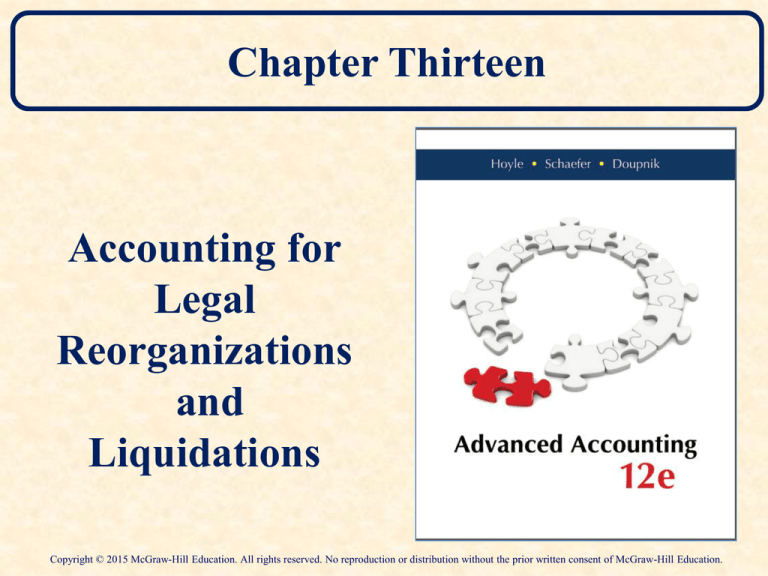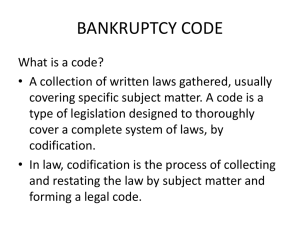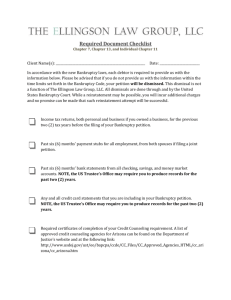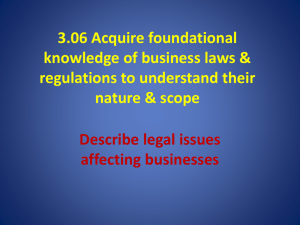
Chapter Thirteen
Accounting for
Legal
Reorganizations
and
Liquidations
Copyright © 2015 McGraw-Hill Education. All rights reserved. No reproduction or distribution without the prior written consent of McGraw-Hill Education.
Learning Objective 13-1
Describe the history and
current status of bankruptcy
and bankruptcy laws.
13-2
Bankruptcy
A basic assumption of accounting is that a
business is a going concern (will remain in
business).
Occasionally, a business becomes insolvent
(unable to pay debts as they come due).
An insolvent business can either cease to
exist, or can seek a legal remedy called
bankruptcy.
13-3
Accounting for Legal Reorganizations
and Liquidations
What happens to a business when it fails?
Who gets the assets?
If the assets are sold, who gets the money?
Are the creditors protected?
How is the business failure reported?
13-4
Size of Recent American Bankruptcies
Company
Bankruptcy Date
Lehman Brothers
07/15/2008
Washington Mutual
09/26/2008
WorldCom
07/21/2002
General Motors
06/01/2009
CIT Group
11/01/2009
Enron
12/02/2001
Conseco
12/17/2002
MF Global Holdings, LTD 10/31/2011
Chrysler
04/30/2009
Thornburg Mortgage
05/01/2009
Total Assets
(in Billions)
$691
328
104
91
81
66
61
41
39
37
13-5
Bankruptcy Reform Act of 1978
The Act strives to achieve two goals in
connection with insolvency cases:
1) the fair distribution of assets to
creditors, and
2) the discharge of an honest debtor
from debt.
13-6
Learning Objective 13-2
Explain the difference between
a voluntary and involuntary
bankruptcy.
13-7
Bankruptcy Reform Act of 1978
Involuntary Bankruptcy
Voluntary Bankruptcy
Creditors file
petition with the
court.
Company files a petition
with courts requesting
bankruptcy.
Can force company
into liquidation
under Chapter 7 or
receiving
protection under
Chapter 11.
When facing prospect of
severe losses or a
difficult operating
environment, companies
will seek voluntary
Chapter 11.
13-8
Criteria for Forcing
Involuntary Bankruptcy
When there are 12 or more unsecured creditors:
At least 3 must sign the petition
Those that sign must have total unsecured
debts of at least $15,325
If there are fewer than 12:
Only 1 must sign
The minimum debt limit remains $15,325
(Debt limit balances are adjusted every three
years based on the Consumer Price Index)
13-9
Court Response to the Petition
Neither a voluntary nor involuntary
petition automatically creates a
bankruptcy.
Bankruptcy Court may reject voluntary
petitions if the action is considered
detrimental to the creditors.
Bankruptcy Court may reject involuntary
petitions unless evidence indicates the
debtor’s inability to meet obligations as
they come due (slowness of payment is
NOT sufficient cause!!)
13-10
Court Response to the Petition
If the court accepts the petition, it grants
an order for relief.
The order for relief halts all actions
against the debtor.
The automatic stay prohibits creditors
from collecting debts without the court’s
permission
A trustee is appointed to oversee the
bankruptcy process.
13-11
Learning Objective 13-3
Identify the various types of
creditors as they are labeled
during a bankruptcy.
13-12
Classification of Creditors
Fully Secured
Net realizable value of the collateral exceeds
the amount of the obligation. These creditors
are completely protected by the pledged
property.
Partially Secured The value of the collateral covers only a
portion of the obligation. The remainder is
considered unsecured.
Unsecured
All other liabilities are unsecured; creditors
have no legal right to any of the debtor’s
specific assets. They are entitled to share only
in any funds that remain after all secured
claims have been settled.
13-13
Unsecured Liabilities
Having Priority
1. Administrative costs related to liquidation
2. Debts arising between the filing date and the
issuance of an order of relief.
3. Employee claims for wages earned and/or benefit
plan contributions earned during the 180 days
prior to filing (limit $12,475 per employee, each
claim).
4. Customer deposits. Limited to $2,775 per
customer.
5. Government claims for unpaid taxes.
13-14
Learning Objective 13-4
Describe the difference between
a Chapter 7 bankruptcy and a
Chapter 11 bankruptcy.
13-15
Liquidation or Reorganization?
How will the debtor be discharged
from its obligations?
Under Chapter 7, the debtor’s assets will be
liquidated and the proceeds distributed to
creditors (based on their priority status) OR
Under Chapter 11, the debtor will be permitted
to reorganize and continue operations.
(These “chapters” refer to the relevant sections
of the Bankruptcy Reform Act)
13-16
Learning Objective 13-5
Account for a company as
it enters bankruptcy.
13-17
Statement of Financial Affairs
To begin bankruptcy proceedings, the debtor
normally prepares a statement of financial
affairs.
This schedule provides information on the
company’s current financial position to help all
parties determine the actions to take.
It is especially important to unsecured creditors
to decide whether to push for reorganization or
liquidation.
13-18
Statement of Financial Affairs
Debtor’s assets and liabilities are reported according
to the classifications relevant to a liquidation.
Assets labeled as:
Pledged with fully
secured creditors.
Pledged with partially
secured creditors.
Available for priority
liabilities and unsecured
creditors.
Debts labeled as:
Liabilities with
priority.
Fully secured
creditors.
Partially secured
creditors.
Unsecured creditors.
13-19
Learning Objective 13-6
Account for the liquidation of
a company in bankruptcy
especially when using the
liquidation basis of accounting.
13-20
Liquidation Chapter 7 Bankruptcy
1.
Interim Trustee is appointed by court.
Changes
locks, and secures assets and records.
Posts notices that assets are in possession of US
trustee.
Compiles all financial records.
Obtains possession of all corporate records.
2. A committee of 3 - 11 unsecured creditors is
appointed to help protect the group’s interest.
13-21
Committee of Creditors
Consults with the trustee concerning estate
administration
Makes recommendations regarding the
trustee’s performance
Submits to the court questions affecting
estate administration
(The selection of this committee is to help
ensure fairness and to protect the creditor
group’s interests.)
13-22
Role of the Trustee
Charged with preserving the assets and
preventing loss of the estate
Has possession and
control of the
debtor’s assets.
Appointed by the
court; approved by
the creditors.
Can void property
transfers made 90
days prior to the
petition filing.
Prepares the
statement of
realization and
liquidation.
13-23
Statement of
Realization and Liquidation
Trustee tracks the liquidation of a company’s assets.
Included Information
1. Account balances at the date on which the
Order for Relief was filed.
2. Cash receipts generated by sale of property.
3. Cash disbursements by the trustee.
4. Write-offs and recognition of previously
unrecorded liabilities.
13-24
Liquidation Basis of Accounting
April 2013 - FASB issued Accounting
Standards Update No. 2013‐07:
“Liquidation Basis of Accounting,” which
is to take affect for annual reporting
periods beginning after December 15,
2013.
FASB addresses four essential questions
about a company being liquidated.
13-25
Liquidation Basis of Accounting
1 When is a company viewed as actually being in
liquidation so that the liquidation basis of
accounting is applied?
2 At a minimum, what statements should be
reported during liquidation to be in conformity
with U.S. GAAP?
3 How should the liquidating company’s assets be
reported during this period?
4 How should the liquidating company’s liabilities
be reported during this period?
13-26
Liquidation Basis of Accounting
Liquidation basis is first applied when liquidation
becomes imminent, that is:
1. when a plan has been approved by the court or
by people who have such authority and
2. the chance that the plan will be blocked or that
the entity will return from liquidation is remote.
Proper approval of the plan is usually the point at
which the liquidation basis becomes required by
U.S. GAAP.
13-27
Liquidation Basis of Accounting
Financial reporting for the liquidating entity:
must include a statement of changes in net assets in
liquidation to investors and other claimants.
An income statement or a statement of
comprehensive income serves little purpose.
Company must issue a statement of net assets in
liquidation to allow all interested parties to gain
information about the net assets available for
distribution.
13-28
Liquidation Basis of Accounting
On the Statement of Net Assets:
assets are reported at the estimated amount of
cash (or other consideration) expected as a
result of the liquidation process (a figure not
necessarily the same as fair value).
all of the assets of the company that can be
used to generate cash during the liquidation
process are reported.
13-29
Liquidation Basis of Accounting
Liabilities:
No attempt is made to anticipate the legal
release that might come from the bankruptcy
process.
liabilities continue to be reported as normal
unless actual changes take place.
the company should accrue the estimated
costs to dispose of its assets as well as other
costs that are expected.
13-30
Learning Objective 13-7
List the provisions that are
often found in a bankruptcy
reorganization plan.
13-31
Reorganization Chapter 11 Bankruptcy
A legal way to “salvage” a company rather
than liquidate it.
The company is temporarily protected from
its creditors.
Creditors are encouraged to negotiate new
terms with the company.
13-32
Reorganization Chapter 11 Bankruptcy
Control of the company is normally
maintained by the owners (“debtor in
possession”)
Creditors may take over as new owners.
Workers keep their jobs.
Suppliers keep their customers.
Customers maintain their source of supply.
13-33
Reorganization Chapter 11 Bankruptcy
A plan of reorganization must be put forth within 120
days and approved within 180 days by the debtor in
possession.
Examples include Plans:
Proposing changes in company’s operations.
For generating additional monetary resources.
For changes in management of the company.
To settle debts that existed when the order of relief was
issued.
13-34
Reorganization Chapter 11 Bankruptcy
Acceptance of reorganization plan requires approval by:
Two-thirds of the dollar amount and more than
one-half of the creditors who vote
Two-thirds of each class of stockholders who vote
Confirmation by the court
The court can also force acceptance of a plan that
was voted down (known as a “cram down”).
As a final alternative, the court can convert a
Chapter 11 Bankruptcy to a Chapter 7 Liquidation
at any time.
13-35
Learning Objective 13-8
Account for a company as it
moves through reorganization.
13-36
Financial Reporting
During Reorganization
Reorganization raises specific accounting questions :
Differentiating income from operations and
transactions connected to the reorganization
Reporting debt
Reporting basis of assets due to reorganization
FASB’s Accounting Standards Codification Topic
852, Reorganizations, requires financial statements
be prepared
During the reorganization and
When entity emerges from reorganization.
13-37
The Income Statement
During Reorganization
Gains, losses, revenues and expenses of the
reorganization are reported separately from
normal operations on the income statement.
Interest does not usually accrue on the debt
owed as of the date of reorganization.
Interest revenue that would not have been
earned except for bankruptcy is reported
separately as a reorganization item.
13-38
Balance Sheet
During Reorganization
Assets are still reported at book value.
Current versus noncurrent classification not
applicable for liabilities subject to reduction by
the court’s acceptance of the plan.
These
liabilities should be reported separately at
the amount of the claims.
Liabilities not subject to reduction are all
shown as current versus non-current.
13-39
Learning Objective 13-9
Describe the financial
reporting for a company that
successfully exits bankruptcy
as a reorganized entity.
13-40
Fresh Start Reporting
When a company emerges from Chapter 11,
GAAP permits fresh start reporting if two
conditions are met:
1. The reorganization (or market) value of the
assets are less than the total of the allowed claims
as of the date of the order for relief plus any
subsequent liabilities.
2. The original owners are left with less than
50% of the voting stock.
13-41
Fresh Start Accounting
Fresh Start Accounting
Assets are restated to individual current value.
Liabilities (except deferred income taxes) are
stated at the present value of future cash
payments.
Normally, APIC is adjusted to balance.
Retained Earnings is set to zero.
13-42





